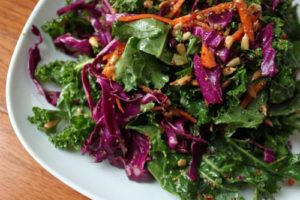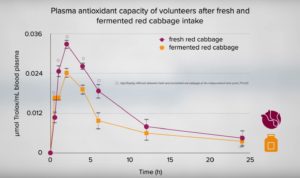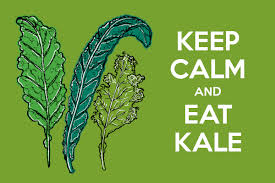
You may have heard that kale and cabbage are sometimes regarded as “super foods“, but is this just the usual hyperbole, or is there some factual basis for this? Some research results might help us to decide the answer – specifically, in relation to the oxidation of LDL (so-called ‘bad’) cholesterol.
A 2014 study 1 found that eating a bag of frozen kale and cabbage a day for just two weeks caused “significant reductions” of total cholesterol, LDL cholesterol, and even blood sugar levels. Additionally, the antioxidant capacity of the study subjects’ blood went up. This resulted in “a significant decrease” in oxidised LDL.
Blog Contents
Oxidised LDL
We know that raised LDL levels are bad for you (associated with increased risk of heart disease, etc 2 ), but oxidised LDL is even worse. 3 So, the fact that kale and cabbage can reduce the amount of oxidised LDL in your blood is, just in itself, an excellent reason for filling your freezer and larder with these super veggies.
Fermented kale and cabbage
Fermenting them (as in sauerkraut) has been shown, specifically in the case of red cabbage, 4 to reduce the nutrient power of the veg as well as introducing the problem of added salt – often lots of it. The reduction in the antioxidant power of fresh red cabbage once it’s fermented can be seen in the following chart from the latter study:

Cooked or raw?
So, what about cooking kale and red cabbage – does this also destroy some of the antioxidant and other nutritionally-positive properties compared with eating them raw? Apparently not. Indeed, a 2016 study 5 found that certain cooking methods actually improve the levels of bioactive compounds, including the antioxidant component. This is pretty good news since, although red cabbage and other cabbage varieties are perfectly okay to eat raw, chewing through raw kale is not really something that most of us would look forward to doing, irrespective of the health benefits.

Best cooking method?
The study tried three different methods – boiling, steaming, and stir-frying. Of the three, the conclusion was that steaming your kale and cabbage is probably the best option. Personally, I would have been interested in seeing the results if they had also included microwaving in the list of cooking methods, since some research 6 7 8 9 raises the possibility that microwaving (at low power setting, for relatively short periods of time, and with very little added water) is possibly one of the best ways of preserving nutrients in cooked foods.
But, as Dr Greger so succinctly puts it: “…with foods that healthy, the truly best way to prepare them is whatever way will get you to eat the most of them.” 10 .

References
- Bacchetti T, Tullii D, Masciangelo S et al. Effect of black and red cabbage on plasma carotenoid levels, lipid profile and oxidized low density lipoprotein. J Funct Foods. 2014;8:128-137. [↩]
- Practice Pointer
Managing dyslipidaemia for the primary prevention of cardiovascular disease. BMJ 2018. [↩] - Fraser GE. Diet and coronary heart disease: beyond dietary fats and low-density-lipoprotein cholesterol. Am J Clin Nutr. 1994;59(5 Suppl):1117S-1123S. [↩]
- Wiczkowski W, Szawara-Nowak D, Romaszko J. The impact of red cabbage fermentation on bioavailability of anthocyanins and antioxidant capacity of human plasma. Food Chem. 2016;190:730-740. [↩]
- Murador DC, Mercadante AZ, de Rosso VV. Cooking techniques improve the levels of bioactive compounds and antioxidant activity in kale and red cabbage. Food Chem. 2016;196:1101-1107. [↩]
- J Am Diet Assoc. 1985 Aug;85(8):922-6. Effects of microwave cooking/reheating on nutrients and food systems: a review of recent studies.
Hoffman CJ, Zabik ME. [↩] - Harvard medical School. Microwave cooking and nutrition. Is microwave food healthy? Updated: August 1, 2017 [↩]
- J Food Sci. 2009 Apr;74(3):H97-H103. doi: 10.1111/j.1750-3841.2009.01091.x. Influence of cooking methods on antioxidant activity of vegetables. Jiménez-Monreal AM1, García-Diz L, Martínez-Tomé M, Mariscal M, Murcia MA. [↩]
- J Agric Food Chem. 2007 Nov 28;55(24):10001-7. Epub 2007 Nov 3. Effects of microwave cooking conditions on bioactive compounds present in broccoli inflorescences. López-Berenguer C, Carvajal M, Moreno DA, García-Viguera C. [↩]
- The Benefits of Kale and Cabbage for Cholesterol. Michael Greger M.D. FACLM May 9th, 2018 Volume 41 [↩]